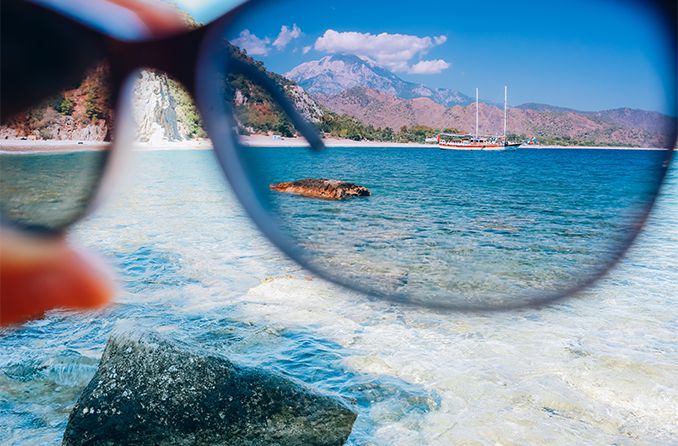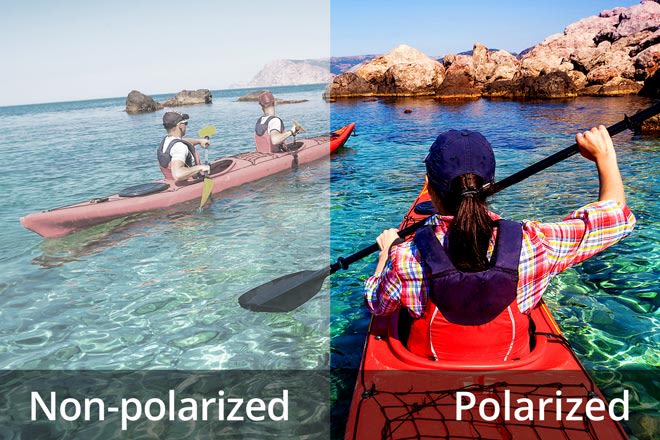What are the advantages of polarized sunglasses?

Polarized sunglasses can benefit your eyesight in all sorts of ways: They reduce glare, boost colors and make daytime driving easier, to name a few.
Mix the benefits together and you’re left with a hefty perk: the ability to enhance your vision.
The last time you touched up a scenic photo on your phone or computer, did you notice an “auto enhance” or “auto adjust” option? Maybe a little magic wand icon? You know, the one that automatically processes your picture and makes it look more picturesque and dramatic.
What if you could step outside and see the world in constant auto-enhance mode?
Wearing polarized sunglasses can make you feel like you’re in a living Instagram picture, like a hidden editing tool is constantly reducing glare and making everything around you more vibrant.
However, there are certain times when these glasses might not be the best option. We’ll get into the pros and cons, and see if they’re right for you.
What is polarization?
When light comes directly from a source, its light waves travel vertically, horizontally and all sorts of angles in between. A polarized lens filters this “raw” light and allows only vertical waves to pass through.
This is how polarized sunglasses get their best feature: the reduction or elimination of glare.
Reflected light waves, glare included, are often horizontal in nature; they have a harder time getting past the vertical filter of a polarized lens.
The many benefits of polarized sunglasses
Glare reduction can boost visual comfort in many different ways — some that may be more surprising than others.
Daytime driving safety
When sunlight hits curved windshield glass, it spreads out into bright, distracting glare. Polarized sunglasses can block much of it, especially on a clear or partly cloudy day.
Reducing windshield glare makes your view of the road a little more like the view you’d have without a windshield at all. Driving is safer when you can focus on the road instead of having to adjust your view or shield your eyes from bright streaks of light.
Fishing and boating

Polarized sunglasses provide superior glare protection — especially on the water.
The ability to see what’s swimming below the water’s surface reflections is a big advantage for many types of fishing, for both location scouting and seeing what you’re reeling in before it breaks the surface.
For the same reason, polarization can turn canoeing, kayaking and sailing into an entirely new experience. Think of it as above-water snorkeling.
SEE RELATED: The best sunglasses for fishing: Insights from a Bass Pro couple
Vibrant outdoor colors
When it comes to natural scenery, few things are as satisfying as looking up at a vast, open sky that almost seems bluer than blue.
But tiny particles within humid or polluted air can dim that blue color, giving it a white, yellow or gray overcast.
When a polarizing lens stops the reflections from those particles, the sky can often retain its deep blue appearance. Contrasted against green leaves or white sand, it can be a real visual treat.
Photography
A polarizing filter is a popular photography accessory placed over a camera lens. Much like glasses, it can cut through reflections and make natural colors more vibrant.
If you use one of these filters, wearing polarized sunglasses lets you step back from the viewfinder and get a better idea of what your photo will look like in real time.
SHOPPING FOR SUNGLASSES? Find an optical store near you for prescription and non-prescription shades.
Are there any disadvantages?
While polarization is usually beneficial, there are certain situations where “too much of a good thing” holds true.
Night driving
It’s easy to think that glare reduction would make night driving safer. While that’s true in certain situations, it’s not always the case.
The American Academy of Ophthalmology suggests that polarized lenses at night could actually be detrimental since they can restrict too much light in a situation where there is already so little.
Instead of using special glasses for driving, they recommend cleaning your car windows and headlights, replacing worn wiper blades and making sure any eyewear prescriptions you have are up to date.
Skiing
This is a tricky one. Polarization can reduce sun glare from ultra-reflective snow and ice, but that can also be its downfall.
Skiers may have a hard time dealing with patches of ice or hardened snow if they can’t see them in the first place. Less bright light is usually a plus, but in this case it can be a hazard.
Standard, non-polarized sunglasses or snow goggles are typically recommended for skiing.
Some digital screen use
Polarized lenses can dim the brightness of certain digital screens, like the ones found on your smartphone, GPS and calculator.
Luckily, this dimming effect usually only happens when you look at a screen from an unusual angle. For example, your phone screen might be completely visible while you’re holding it upright, but too dark to read when you rotate it to a 45-degree angle.
SEE RELATED: Computer eye strain: 10 steps for relief
Are polarized sunglasses better?
In most cases, yes, polarized sunglasses are better.
They can block distracting glare, reduce reflections and make a sunny day look like it belongs on a postcard.
However, as you’ve seen, there are a few scenarios when they don’t work as well.
It all depends on how you plan to use them, and it’s not uncommon for people to own a polarized pair for some situations and non-polarized, “regular” sunglasses for others.
If you’ve never tried these sunglasses, consider a quick trial run at your local optical store — ideally on a sunny day. Look around the store and out the window. Where do you see the biggest differences in clarity and vibrancy? The sky, the car windshields, the roads?
Polarized lenses aren’t for everyone. But if they’re right for you, they might change the way you see the world.
WHEN WAS YOUR LAST EYE EXAM? Find an eye doctor near you and book an appointment.
Page published on Sunday, January 26, 2020






